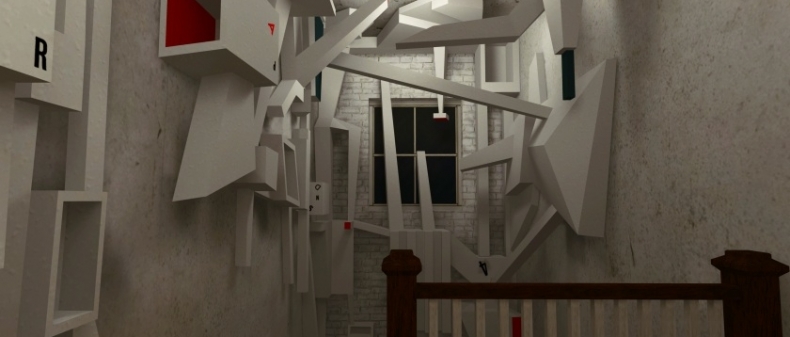
“I did never know so full a voice issue from so empty a heart.” – Henry V
I first encountered Void, and its designer, Luis Hernandez (of Necrophone Games), while sitting on a panel entitled Virtuosity: Heavy Metal and Video Games, with game designer Benjamin Rivers (best known for creating the horror game Home) and Adam Hines (one half of the Guys With Pencils gaming and animation podcast and blog). The panel discussion took place at Bento Miso, a local co-working space for game developers and web professionals, which also serves as a hub and incubator for indie gaming in Toronto.
After a passionate discussion about everything from kickass soundtracks to aural vs. virtual violence and catharsis, moderator Rachel Kahn asked Luis Hernandez if he wouldn’t mind playing – or, perhaps, performing – Void, a game he recently created but has yet to release.
Words like “rapt” and “all-consuming” get tossed around a little too easily, especially when describing music that’s as difficult as it is absorbing, but Void absolutely captured me for the entire time I was experiencing it projected onto a screen behind me. The environments were strange, alien – by turns either vast and lonely or sharp and claustrophobic– and the music was less a wall than a wave, muscular and liquid, pressing as much against the body as the ear.
The best way I can describe Void is a cross somewhere between a wall-of-sound drone record and an exploratory puzzle game. Each level is composed of a different landscape, paired with a unique drone and noise track. The aural environment is an extension of the physical environment, both in form and content, theme and execution. As the player moves throughout each environment, the sounds change, becoming louder, quieter or transforming entirely. Some sounds may fade into to background, while others come to the forefront.
Each level, in this way, is a maze, both in the physical sense and in terms of the sound. Once the player has navigated each level in a particular way, touched the landscape and changed the soundscape, the game progresses to the next. Hernandez can play through the game incredibly quickly as a demonstration, but it’s easy to get lost in a level – in the spatial complexity and sonic density – for hours.
Each level, and its accompanying soundscape, becomes the character in the game, as well as the faceless, voiceless explorer the player controls, who can only have an impact on the environment by moving through it. For a game devoid of sentient beings, aside from the player, it can be a surprisingly threatening environment. Whether a deserted, foggy city street in a light snowfall, a gravity-mad, twisted room scrawled with broken graffiti or the wind-scraped, barren wasteland of a ruined planet, shells of buildings standing out like twisted bones, it’s the settings in Void that the player has to worry about. There’s no need for monsters – the places are inhabited, or haunted, enough.
The sounds, then, become almost comforting to the player – the guideline and compass the player must follow to leave one space and progress to the next. No matter how difficult, ominous or acerbic the sounds, the aural landscape is the closest thing to assistance the player is going to receive. A line guiding you out of the Minotaur’s lair is still a help and blessing, even if it’s made out of barbed wire instead of golden cord.
Hernandez says that he was greatly influenced by drone, doom and sludge metal while writing the music for Void, “especially material from the UK. The project was started in January 2012, during the dead of winter. I imagine they have equally bleak winters in the UK, just grey for months and months – no sunlight. I felt very in-tune with that sound.” He lists other influences, including classic musique concrète, electro acoustic and noise. He also attempted to match the type of audio equipment he used with the specific environment he was writing for, such as choosing “simpler instrumentation for more antiquated locations.”
Hernandez says that he made Void, in part, as an attempt to address his “dissatisfaction with the genres of music that are used both as influence and as content in games today. I can think of very few games that break out of the licensed music, orchestral score and chip tune nostalgia stuff.” He adds that these kinds of soundtracks are fine in moderation, but he wanted to challenge both the AAA and indie game soundtrack status quo by exploring a different way of doing things.
Even more so, Hernandez says that Void “was created to explore the relationship between composed sounds and ‘composed’ locations. I feel like there was a brief exploration of this relationship during the late ’90s, when some profoundly talented young directors were given large budgets to sculpt music videos. That era is dead now, but it was highly influential on my perception of music and its potential environment. I’m still trying to explore that relationship.”
While Void is very much an interactive game, one that I experienced for the first time as a kind of performance, Hernandez is quick to point out that he doesn’t view playing the game as a performative act. He states that if it were truly a game that allowed the user to “make” music, there would be a set of tools available for the player to access. He does note, “there are a couple areas in Void where I’ve seen people play with it and want to take screenshots, so perhaps there is some element of ‘creation’ for others.”
However, that’s the limit of the player’s control; they are not agents of creation so much as at the mercy of it. Hernandez sees the player as “closer to a stylus running along a track in a record, or a laser scanning around a CD. I wouldn’t consider the laser to be composing or performing; it’s more like it’s fumbling around a dataset, looking for things it can read. In most games, players are given agency to explore, but not necessarily to create.”
Hernandez may not have intended players to be active agents of creation while in Void, but he does want them to listen. He states, “I like to think of it as multiple tiers of exploration; you should be just as interested in ‘hearing’ what’s over there as ‘seeing’ what’s over there. It’s true that the music or audio in most games falls into the background, is forgotten or passive. I wanted it to be a crucial component to the experience in Void. I wish more people actively listened to music; musicians usually do, or at least they listen for the specific instruments they’re trained to play, in a composition.”
Void isn’t yet commercially available in any capacity; Hernandez says that he is still trying to determine the best way to release it. He comments that the game feels like it is “between worlds,” difficult to define and market; he might prefer to “bundle it with similar works, and as a larger package it may prove easier to release.”
It is my sincere hope, in making more people aware of the fact that Void exists, that a full-scale release or bundle will become a much more viable option for Hernandez. I begged him to let me play with a copy, and he mercifully obliged; I’ve been torturing myself with it ever since.
(Also, because it is awesome, here is a video of Luis Hernandez performing live, with a back-mounted amplifier that he designed to enable him to have freer movement while performing without losing volume or sound quality.)
Void will be featured at Vecotr: Game + Art Convergence, and game art festival and Symposium taking place in Toronto from February 21st–24th at various venues in Toronto.
____
Natalie Zina Walschots is a poet and music writer based in Toronto, Ontario. Her second book of poetry, DOOM: Love Poems for Supervillains, was published by Insomniac Press this spring. You can follow her on Twitter at @NatalieZed.
For more, follow us on Twitter at @torontostandard, and subscribe to our newsletter.














